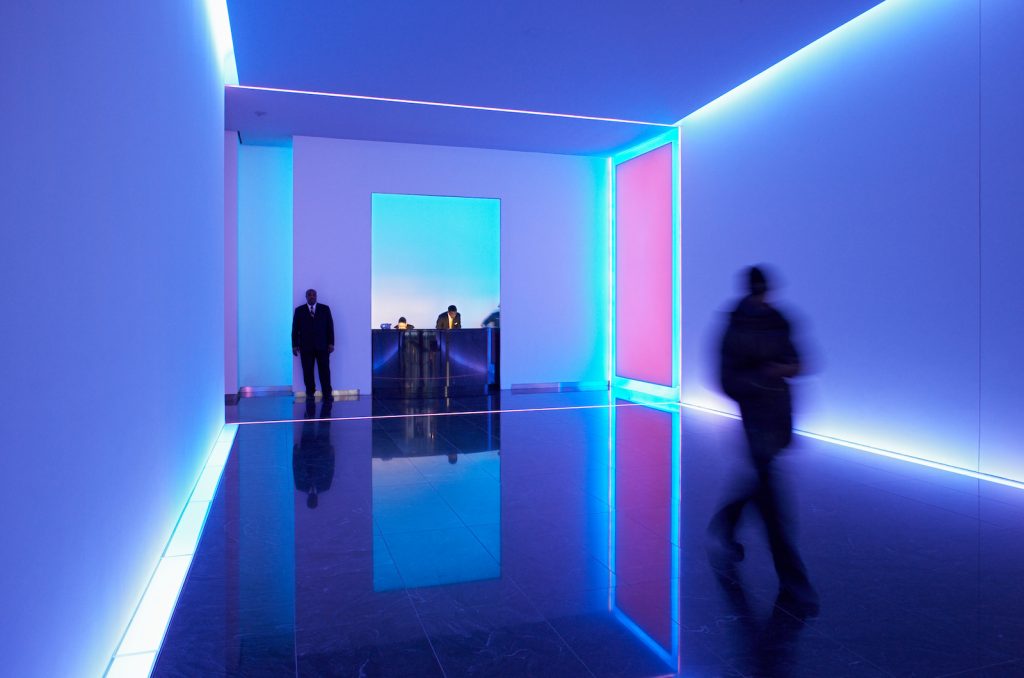“Art has come out of its ivory tower and into the office building lobby,” New York Times architecture critic Ada Louise Huxtable wrote in 1959. That is only more true today, as corporations have seen the advantage of wowing their visitors and potential clients with works by brand-name artists, especially as the art market has continued to grow and make global headlines.
These works extend the great tradition of public art in New York into the indoors, and allow office workers to have a moment of beauty, aesthetic challenge, or intellectual interest on their way to work each day.
The future of art in corporate lobbies can be subject to the vagaries of time and, especially, changes in ownership. For example, the sculptor Isamu Noguchi created a site-specific installation in the lobby at 666 Fifth Avenue in 1957; when Brookfield Properties took over the lease in 2020, they wanted to remodel, and argued that intervening renovations to the building that changed the context meant the installation no longer reflected Noguchi’s vision. They dismantled it and donated it to the foundation that cares for the artist’s work.
Lobby art doesn’t necessarily have the reputation of being the most interesting or cutting-edge. Never one to shy away from pronouncing a bold opinion, the New York Post once boldly prounounced that “Lobby art sucks.” But that’s not necessarily the case. Some does, some doesn’t, and Artnet News is here to guide you.
What are some of the best and worst choices for art installed in office lobbies across New York City? Here’s a quick roundup of five superlatives—from the worst to the best—to guide you as you look for art in different places in your travels throughout the city, if you are seeking something different from the museum and gallery circuit.
Most Lame Visual Joke: Anish Kapoor at 56 Leonard
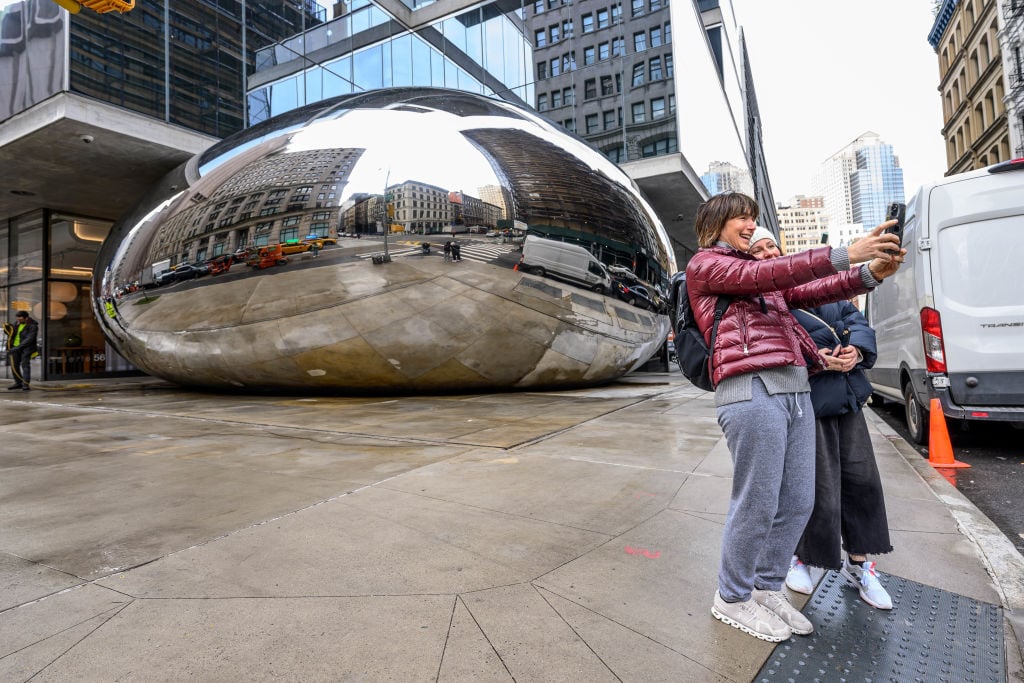
A new permanent public artwork by artist Anish Kapoor at 56 Leonard Street in Manhattan. Photo: Roy Rochlin/Getty Images.
The British-Indian artist’s first public artwork in New York is, in a way, a miniature cousin of his massive Cloud Gate, which has graced Chicago’s Millennium Park since 2006.
Estimated to have cost as much as $10 million, the as-yet-untitled shiny sculpture is 48 feet long, weighs 40 tons, and is installed under the corner of a new Herzog & de Meuron–designed luxury tower at 56 Leonard Street in Tribeca. The new Lower Manhattan skyscraper is commonly referred to as the Jenga Tower for its distinctive shape.
While it might be a stretch to call the piece lobby art, since it’s outdoors, we think it’s close enough. And while the Chicago work is rightly beloved as a unique piece of public art, this one makes a lame joke, seeming to be bulging under the weight of the building that hosts it.
ArtNews’s Alex Greenberger wrote when it was unveiled that “this sculpture is no Cloud Gate, and personally, I wouldn’t mind if the building above it made good on its promise and crushed the thing altogether.”
Most Predictable: Jeff Koons, Balloon Rabbit (Red), at 51 Astor Place
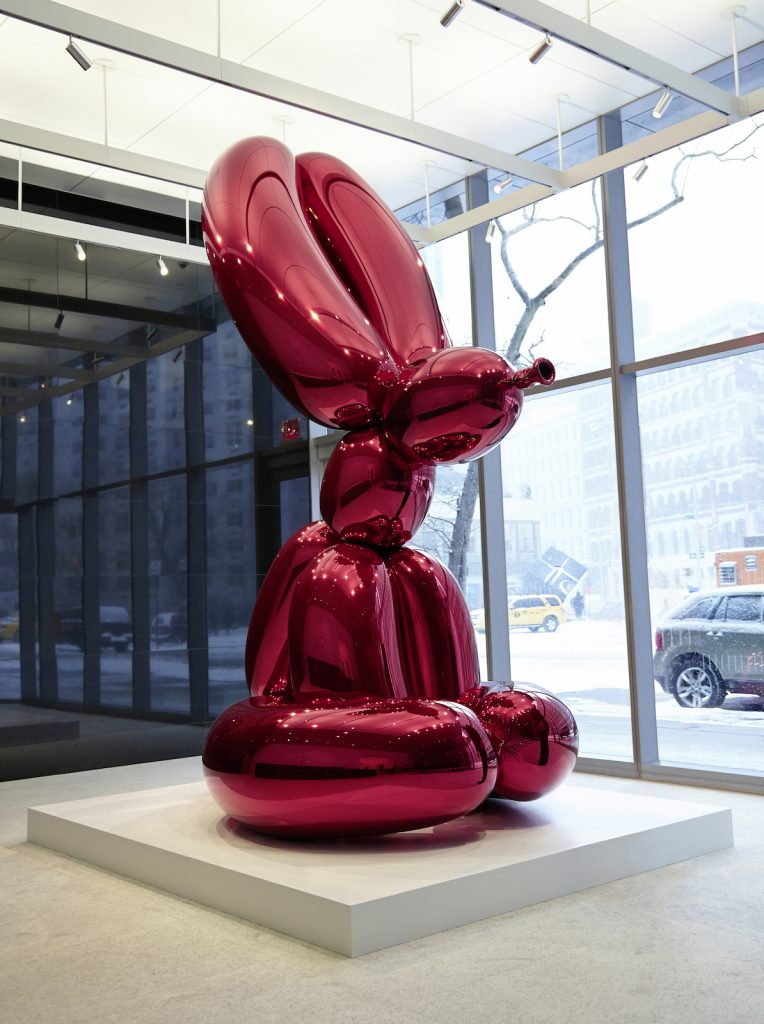
Jeff Koons, Balloon Rabbit (Red) (2005–10). Photo: Tom Powel Imaging. Courtesy the artist. © Jeff Koons.
Balloon Rabbit (Red), 2005–10, which stands 14 feet tall and tips the scales at 6,600 pounds, has squatted (or whatever it is rabbits do) in the lobby of 51 Astor Place since 2014.
It comes from the collection of Edward J. Minskoff, whose equity company erected the 13-story, 430,000-square-foot building, where IBM is the anchor tenant in a neighborhood that has drastically gentrified over recent years. Just a few feet away, at Cooper Square, legendary conceptual artist David Hammons once performed his Bliz-aard Ball Sale (1983), in which the artist commented on the salability of whiteness and the absurdity of the art market by offering snowballs in various sizes to passersby on the sidewalk.
And speaking of the selling of whiteness and market madness, in 2019, Koons’s 3-foot-tall stainless-steel Rabbit (1986) fetched $91.1 million at Christie’s New York, setting a record for the priciest work ever sold at auction by a living artist.
Having an artwork by a former Wall Street commodities broker from the collection of an equity guy dominating a lobby where giants like IBM are tenants is just so on the nose that to call it on the nose would be too on the nose.
Most Journalist-Friendly: Ben Rubin and Mark Hansen, Moveable Type, at the New York Times Building
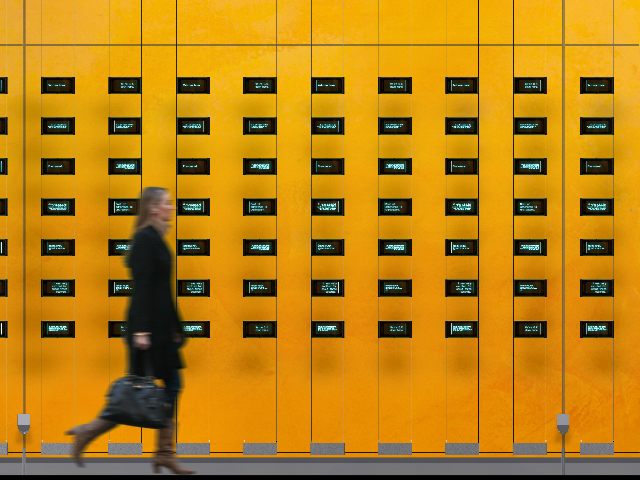
Ben Rubin and Mark Hansen, Moveable Type (2007). Courtesy: New York Times.
When the New York Times moved into its $1 billion, Renzo Piano–designed Midtown Manhattan headquarters in 2007, the paper’s architecture critic Nicolai Ouroussoff wrote (where else?) in the Times that he was “enchanted” with the building.
Though Ouroussoff didn’t mention it in his review, one element that enchants most people’s visiting the building is Moveable Type, a digital artwork by New York artist Ben Rubin and Columbia University journalism professor Mark Hansen.
The piece uses algorithms to parse selections of text from the paper’s daily output, as well as its archive and reader comments, which appear on some 560 small digital displays arrayed in two nearly 54-foot-wide grids. One algorithm, for example, pulls out noun phrases, another maps, another phrases containing numbers, yet another questions, as Rubin explains in a video (which, impressively, explains how many bad ideas they went through to arrive at this one).
Most Literary: Jenny Holzer, 7 World Trade Center

Jenny Holzer, For 7 World Trade (2006). Photo: Joe Woolhead, courtesy Silverstein Properties.
Rebuilt at a cost of some $700 million, 7 World Trade Center was the first office building to reopen at Ground Zero, five years after the terrorist attacks of September 11, 2001. So a public art commission for this emotionally fraught site must have been daunting. But Jenny Holzer (who indeed told the New York Times that she was “taken aback at the gravity of the project”) rose to the challenge with a work that captures decades of expressions about the city’s pleasures.
Stretching 65 feet wide and 14 feet high, Holzer’s For 7 World Trade was inaugurated in May 2006. The five-foot-high scrolling letters come from poems and prose texts about “the joy of being in New York City,” she told Art21, including works by writers like Elizabeth Bishop, Langston Hughes, Walt Whitman, and William Carlos Williams, each writing about their first impressions of Gotham. In 2019, she added writing from 18 New York schoolchildren, and the text runs for a full 36 hours before repeating itself.
Besides the literary content, Holzer focused on a satisfying chromatic experience, saying, “I want color to suffuse the space and pulse and do all kinds of tricks.”
Most Straight-Up Coolest: James Turrell, Plain Dress 2006, at 505 Fifth Avenue
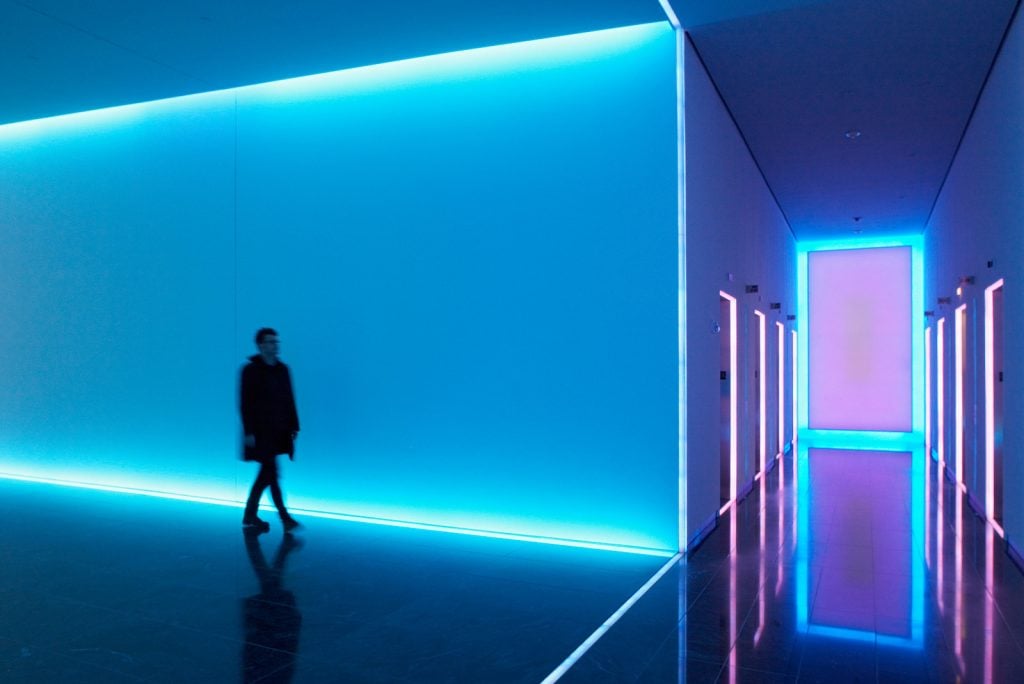
James Turrell, Plain Dress (2006), at 505 Fifth Avenue. Photo: H.G. Esch, courtesy KPF.
California Light and Space artist James Turrell is globally known for his Skyspaces and other installations that employ natural light and illumination to cast a spell. Construction is ongoing on his magnum opus, Roden Crater, in Northern Arizona.
While we wait for that, we can see a small and subtle work, a collaboration with architects Kohn Pederson Fox, in the lobby of Midtown’s 505 Fifth Avenue. As recounted in Architect magazine, the client wanted to invite an artist to create a work in the lobby in collaboration with the architects. During the building’s development, KPF design principal Douglas Hocking made an offhand remark about the light in a rendering of the lobby reminding him of Turrell, and it was off to the races.
Turrell transformed the lobby into a forced-perspective lightbox. Cabinets of light, vertical rectangles reminiscent of Mark Rothko paintings, anchor the installation. Behind their resin surfaces, a bank of LED lights is programmed to change color over a 24-hour cycle. The meditative interior provides a sublime contrast to the traffic and bustle of Fifth Avenue, just outside the glass entrance doors.
More Trending Stories:
Artists to Watch This Month: 10 Solo Gallery Exhibitions to See In New York Before the End of the Year
Art Dealers Christina and Emmanuel Di Donna on Their Special Holiday Rituals
Stefanie Heinze Paints Richly Ambiguous Worlds. Collectors Are Obsessed
Inspector Schachter Uncovers Allegations Regarding the Latest Art World Scandal—And It’s a Doozy
Archaeologists Call Foul on the Purported Discovery of a 27,000-Year-Old Pyramid
The Sprawling Legal Dispute Between Yves Bouvier and Dmitry Rybolovlev Is Finally Over
